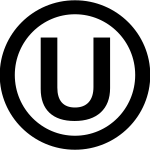Orthodox Union Kosher facts for kids
Quick facts for kids Hechsher of the Orthodox Union |
|
|---|---|
 |
|
| Certifying agency | Kosher Division of Orthodox Union |
| Founded | 1923 |
| Headquarters | 40 Rector St, New York, NY 10006 |
| Key People | |
Orthodox Union Kosher, often called OU Kosher, is a group that checks if food follows kosher rules. Kosher means food is prepared according to Jewish law. This organization is based in New York City. It was started in 1923 by Abraham Goldstein.
OU Kosher is very important in the world of kosher food. It checks about 70% of all kosher food globally. It is the biggest of the "Big Five" main kosher checking groups. Other big groups include OK, Kof-K, Star-K, and CRC.
Contents
What is OU Kosher?
How it Started
OU Kosher began in 1923. It was the first group created just to check if food was kosher. Abraham Goldstein, a chemist, started it. He set up the kosher checking program under the Union of Orthodox Jewish Congregations.
The OU Kosher symbol is an "U" inside an "O". This symbol first appeared on Heinz's vegetarian baked beans. This showed people that the beans were certified kosher.
Growing and Improving
In 1950, Rabbi Alexander S. Rosenberg joined OU Kosher. He helped the group grow a lot. During his 22 years there, the number of mashgichim (kosher supervisors) grew from 184 to 750. These supervisors helped check over 2,500 products for 475 companies.
Rabbi Rosenberg also made important changes to stop cheating in the kosher food world. He made sure that local rabbis working for OU Kosher followed the same rules. He also stopped food companies from trying to bribe the supervisors.
In 2012, OU Kosher launched a special app. This app helps people easily find out which products are kosher. It shows new kosher products and updates on products that are no longer kosher.
As of October 2019, Rabbi Menachem Genack leads the OU Kosher group. He became the leader in 1980. Today, OU Kosher checks almost 1,000,000 products. These products come from over 12,000 factories in 104 countries. With 886 supervisors and over 50 rabbinic coordinators, OU Kosher is the largest kosher checking group in the world.
Women's Role in Kosher
In the early 1920s, the Orthodox Union Women's Branch was formed. Rebecca "Betty" Goldstein led this group. The women made booklets to help Jewish women keep their homes kosher. They also created kosher cookbooks.
Since the women were encouraging kosher homes, they wanted to make sure store-bought foods were also kosher. Members of the Women's Branch visited food factories themselves. They pushed the leaders of the Orthodox Union to do more to check food for kosher standards.
OU Kosher Symbols
OU Kosher uses different symbols to show how a product is certified.
- OU: This means the product is Kosher Pareve. Pareve foods are neither meat nor dairy.
- OU-D: This symbol means the product is Kosher dairy. It contains milk ingredients or was made on dairy equipment. These products might not be kosher for Passover. Dairy products may or may not be Chalav Yisrael.
- OU-DE: This shows the product was made on dairy equipment.
- OU-Meat or OU-Glatt: This means the product is Kosher meat. It has meat ingredients or comes from meat. It can also mean the product was made on equipment used for meat, even if it has no meat itself.
- OU-Fish: This symbol means the product is kosher and contains fish ingredients.
- OU-P: This means the product is Kosher for Passover. Passover foods do not have leavened grain (called chametz) or kitniyot ingredients. These products can be used all year.
- OU-Kitniyot: Like OU-P, this product is Kosher for Passover but does contain Kitniyot. Some people eat Kitniyot on Passover, unlike chametz.
See also

